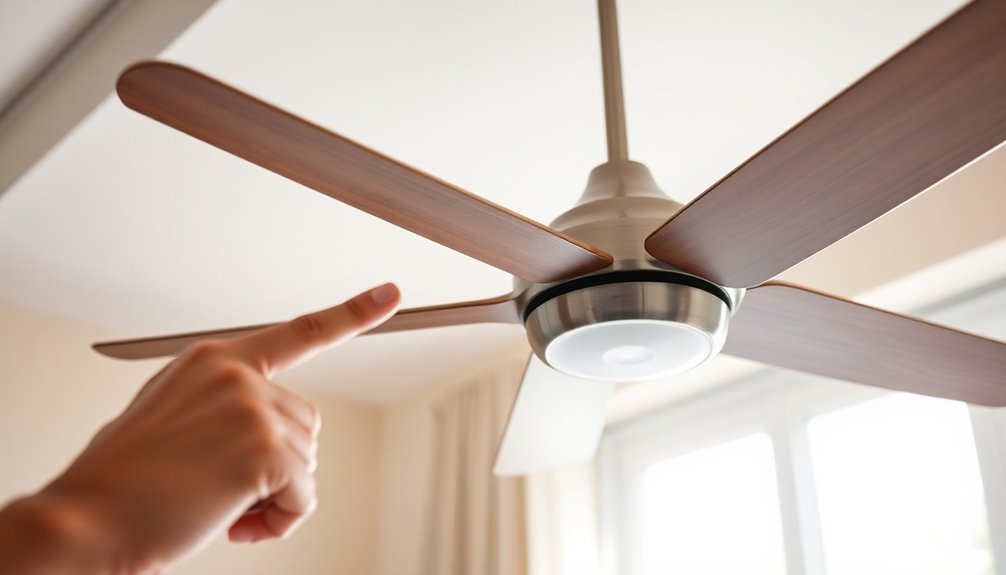Identifying your fan model is simple and crucial for optimizing performance. Start by checking the installation manual or the fan's box for the model number. If your fan's already installed, look on the motor housing or mounting bracket, using a mirror if needed. Remember, model numbers often include letters indicating special features. Consider the fan type and geometry, as these affect airflow and efficiency. Don't hesitate to use manufacturer websites for model-specific advice or customer support if you're stuck. There's plenty more to explore that can enhance your understanding and help you maintain your fan effectively.
Key Takeaways
- Check the installation manual or fan box for the model number, often located in a lower corner or printed on the packaging.
- For installed fans, inspect the motor housing or mounting bracket; use a smartphone or mirror for better visibility if needed.
- Explore manufacturer websites and databases for model-specific information, including FAQs and troubleshooting guides.
- Utilize customer support options like live chat or email for assistance, documenting issues with photos or videos for clarity.
- Engage with community forums for shared experiences and tips that can aid in identifying your fan model efficiently.
Where to Locate the Model Number

When you're trying to identify your ceiling fan model, the first step is knowing where to find the model number.
Check inside the ceiling fan box; the model number is usually on the front of the installation manual in the lower corner. You can also find it printed on the lower corner of the box itself. If you’re experiencing issues with your ceiling fan, checking the model number can help you find the right troubleshooting resources. Many common problems, such as why ceiling fan only runs one speed, can often be addressed by referring to the installation manual. Additionally, you may want to verify if any of the switch settings or wiring connections have been altered, as these can also impact the fan’s performance.
If the fan's already installed, look at the top of the motor housing for downrod-mount fans or the mounting bracket for low-profile fans—look for the number right after "MOD." ID sticker placement is essential for accurate identification.
If it's hard to see, use your smartphone or a mirror to help. Taking a photo can also make it easier to read the model number clearly.
Types of Fans Explained
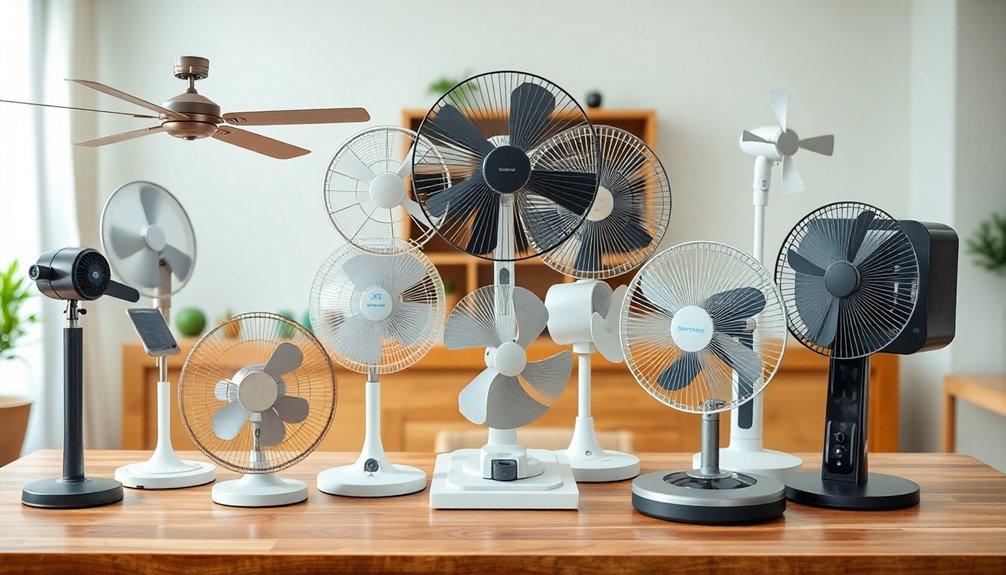
Understanding the various types of fans can help you choose the right one for your needs.
Axial fans, with airflow parallel to the shaft, come in several types like C-wheels, A-wheels, and K-wheels, each suited for different efficiency and adjustability needs.
On the other hand, centrifugal fans, or radial fans, direct airflow radially and include F-wheels, B-wheels, P-wheels, and T-wheels, catering to various pressure and energy consumption requirements with varying pressure head.
Mixed flow fans combine axial and radial airflow, making them ideal for applications needing both high volume and pressure.
Lastly, cross flow fans circulate air in a specific pattern, often used in industrial settings for ventilation and material transport.
Selecting the right fan type is crucial for optimal performance.
Tools for Reading Model Numbers

Finding the model number of your fan can be straightforward if you know where to look.
Start by checking the packaging; it's usually on the outside in the lower corner or inside the installation manual. If you bought the fan online, look at your emailed receipt for the model number.
Next, examine the fan itself. For downrod-mount fans, the ID sticker is on the motor housing, while low profile fans have it on the mounting bracket. Model numbers can also include a letter at the end, which can help identify specific fan specifications.
Use a mirror or take a photo with your phone to see it better.
Lastly, inspect the fan assembly. If you can't find it, don't hesitate to check multiple locations or refer to any included part guides.
Additional Tips for Identification
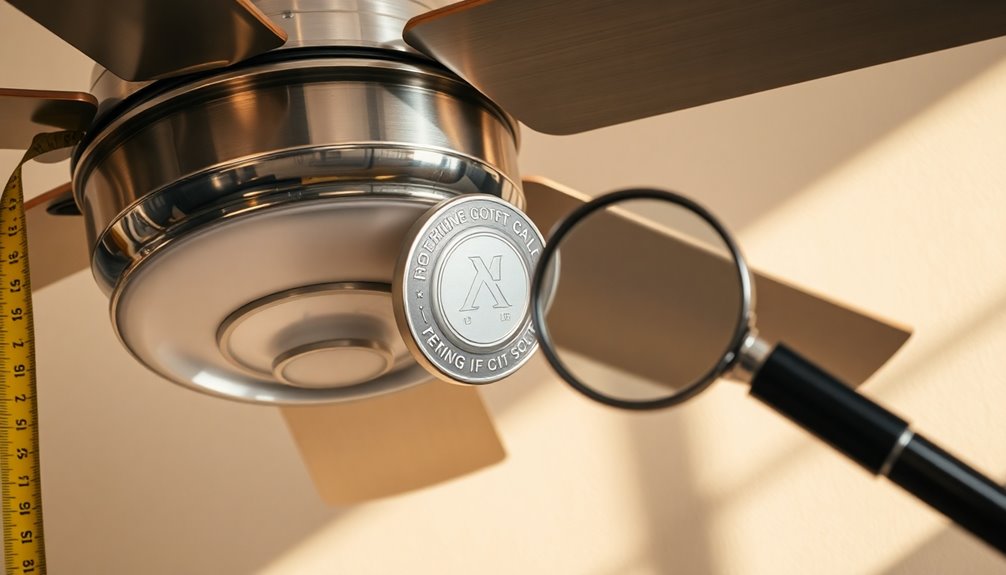
Identifying your fan model can be easier if you take a systematic approach. Start by inspecting the motor housing for stickers, brand embossing, or any visible model numbers. Don't forget to note the manufacturer's name and location. Next, examine the fan components, focusing on blade design, mounting style, and motor size. Check if the fan has a light kit and measure the CFM rating for airflow efficiency. Knowing the make and model is essential for finding replacement parts that are compatible with your fan. Consult online resources like manufacturer websites and forums to gather more information. You can also use a mirror for hard-to-reach areas or take photographs from different angles. If you're still stuck, consider reaching out to customer support or hiring a professional to help you identify your fan model.
Common Formats of Model Numbers
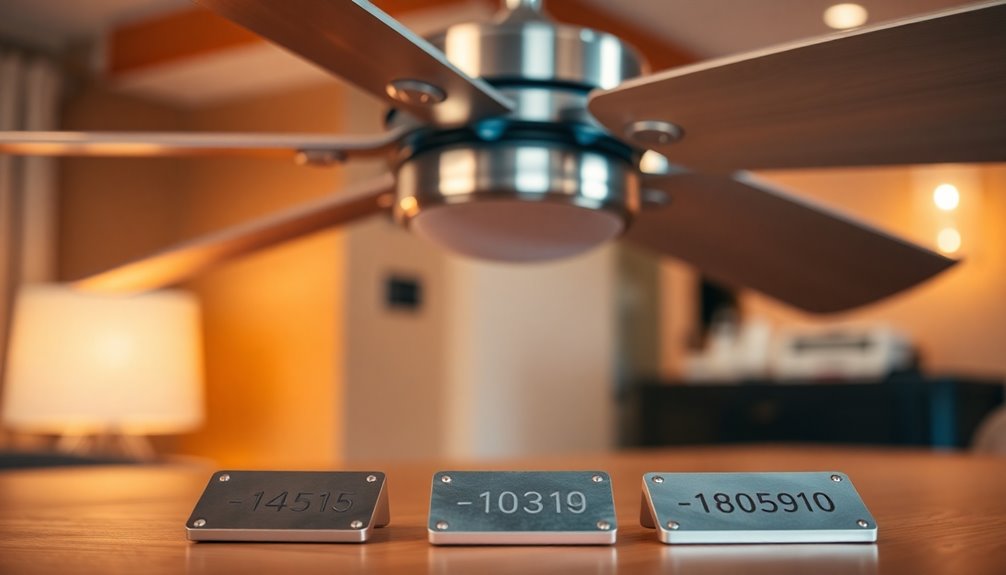
When you're trying to pinpoint your fan model, knowing the common formats of model numbers can greatly simplify the process.
For DC fans, you'll often see frame sizes like 60 mm or 120 mm, alongside airflow levels such as E for efficiency or H for high. DC series identification can also help in quickly recognizing the specific model or feature set associated with your fan.
AC and EC axial fans will typically list square frame sizes and motor types.
Delta fans may present dimensions like 125 x 38 x 45 mm and various airflow levels from LOW to ULTRA HIGH.
Triangle Engineering fans use a series like V or VI, indicating the type of ventilation and horsepower.
Familiarizing yourself with these formats can make identifying your fan model much easier.
Importance of Knowing Your Model

Understanding your fan model is essential for optimizing its performance and ensuring it meets your specific needs. By knowing the model, you can analyze fan performance through fan curves, which illustrate how volume interacts with static pressure and horsepower. This knowledge helps you select energy-efficient fans that reduce energy consumption and lower utility bills. Additionally, understanding your model aids in identifying potential maintenance needs, allowing you to address issues before they escalate.
Compatibility with your current ventilation system is crucial, as is ensuring the fan fits the space requirements for effective air circulation. Ultimately, knowing your fan model not only enhances efficiency but also prolongs the fan's lifespan, saving you time and money in the long run. Understanding fan curves allows for better adjustments to be made for optimal performance in varying operating conditions.
Finding Information in Manuals
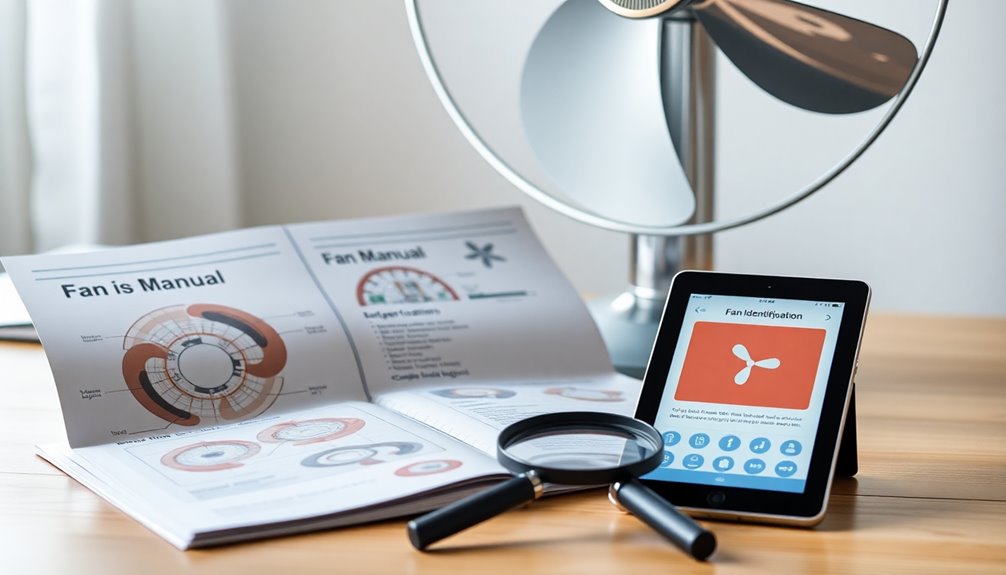
How can you easily find the information you need about your fan? Start by identifying your fan's model number, usually located on the top of the motor housing or on a tag. This unique combination of letters and numbers will guide you to the right manual. Check the manufacturer's label for warranty info and the serial number, which may be needed for support. Different types of manuals—installation, operation, and maintenance—contain essential instructions tailored to your needs. Many manufacturers offer downloadable manuals in PDF format on their websites, making it easy to access them. Use the table of contents or index to navigate quickly, ensuring you find the information relevant to your fan with minimal hassle. If you have specific models, remember that different arrangements may categorize manuals to further assist in your search.
Online Resources for Assistance

After locating your fan's model number, various online resources can help you find the information you need.
The TAL Fan Model Finder allows you to search by model name or identification numbers, making it easy to identify your fan. If you have a serial number, use the Loren Cook Company Lookup to access detailed product records for items shipped since 2007.
For Broan-NuTone fans, model numbers are often stamped on the motor plate or near the outlet. Accurate identification can enhance customer service interactions for support, ensuring you get the assistance you need.
Don't forget about community forums like DoItYourself.com, where members share experiences and tips for identifying fan models.
These resources can streamline your search and provide valuable insights for your specific fan.
Contacting Customer Support
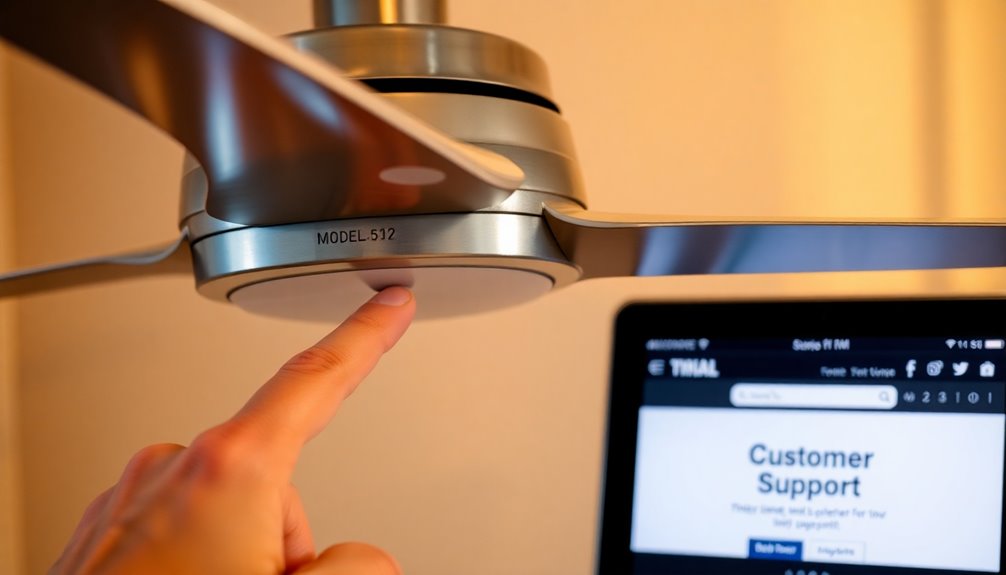
When you're facing issues with your fan, reaching out to customer support can be a straightforward solution.
First, locate the model number on the sticker atop the motor; this helps identify the fan in the manufacturer's database.
Next, visit the manufacturer's website for contact information and resources like FAQs and troubleshooting guides.
If you need direct assistance, call the customer service number, or email them with a detailed description of your issue. You can also use live chat for quicker help.
Don't forget to keep records of all your interactions and provide documentation, such as photos or videos, to facilitate the process. Clear structure in your communication can help ensure your problem gets resolved efficiently.
Following up ensures your problem gets resolved efficiently.
Summary of Key Points

Understanding the key points about fan models can significantly enhance your ability to select and troubleshoot your equipment effectively. Pay attention to fan geometry, including blade count, diameter, and airfoil profile, as these affect performance and efficiency. Additionally, recognize that forced air cooling is essential for high-power-density devices in electronics.
Familiarize yourself with analytical models like Lifting Line Theory and their implementation in MATLAB for predicting performance accurately. Validate your findings through experimental testing, using standardized facilities to measure input and output data.
It's crucial to grasp system identification methods, both non-parametric and parametric, to develop effective control strategies. Lastly, monitor real-time data during experiments to ensure optimal functioning of your fan system.
These insights will empower you to make informed decisions.
Frequently Asked Questions
Can I Identify My Fan Model Without a Manual?
Yes, you can identify your fan model without a manual. Start by checking the packaging; look for the model number printed on the box or your email receipt.
If you have the fan, inspect it closely—find the ID sticker on the motor housing or mounting bracket.
You can also reach out to customer support or visit the manufacturer's website for help. Online forums may provide additional tips, too.
What if the ID Sticker Is Damaged or Missing?
If the ID sticker's damaged or missing, don't worry!
Start by checking the fan's physical characteristics—look for the model name or manufacturer logo on the motor housing.
Inspect additional components like the remote control for any labels.
If you can't find anything, take a photograph and email it to the manufacturer. They might help identify the model.
Lastly, explore online resources for similar models and troubleshooting tips.
Are Model Numbers Unique to Each Fan Brand?
Oh sure, because figuring out model numbers isn't a thrilling ride!
Yes, model numbers are unique to each fan brand. Take Hunter Fans, for instance; they've got their own special five-digit codes.
Then there are Fantasia Fans with names like Mayfair—because who doesn't want a fan named after a fancy place?
Generic brands? Good luck! Their model numbers can be a wild guessing game.
How Do I Know if My Fan Is Still Under Warranty?
To know if your fan's still under warranty, start by checking the warranty documentation that came with it.
Look for the model number and expiration date. If you're unsure, contact the manufacturer's customer support with your fan's details, like the model and serial number.
You can also check online resources or contact the retailer where you bought it.
Keeping your purchase receipts handy will make this process easier.
Can I Use a Fan Model Number for Other Products?
You can't always use a fan model number for other products. Each model number is unique and tied to specific specs like voltage and size, which may not match other devices.
Check the manufacturer's documentation to see if there's compatibility. It's best to verify before trying to mix and match.
If you're unsure, consult user manuals or customer support for clarity. Always prioritize compatibility to avoid installation issues.
Conclusion
Now that you're equipped with the tools and tips to identify your fan model, picture yourself effortlessly locating that elusive model number. Whether you're sifting through manuals or navigating online resources, each step brings you closer to the answers you need. Don't hesitate to reach out to customer support if you hit a snag. With this knowledge in hand, you're ready to breeze through the process and keep your fan running smoothly!
